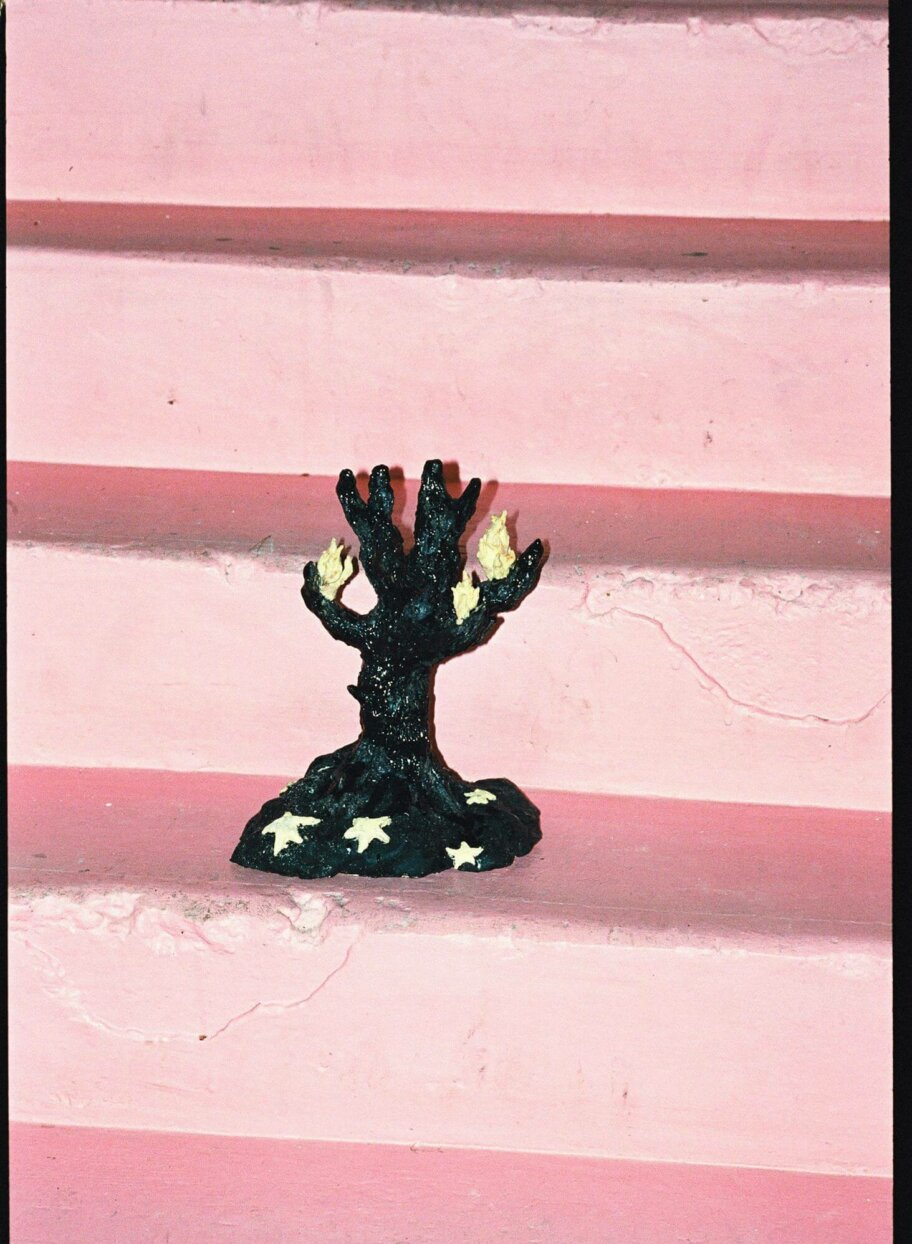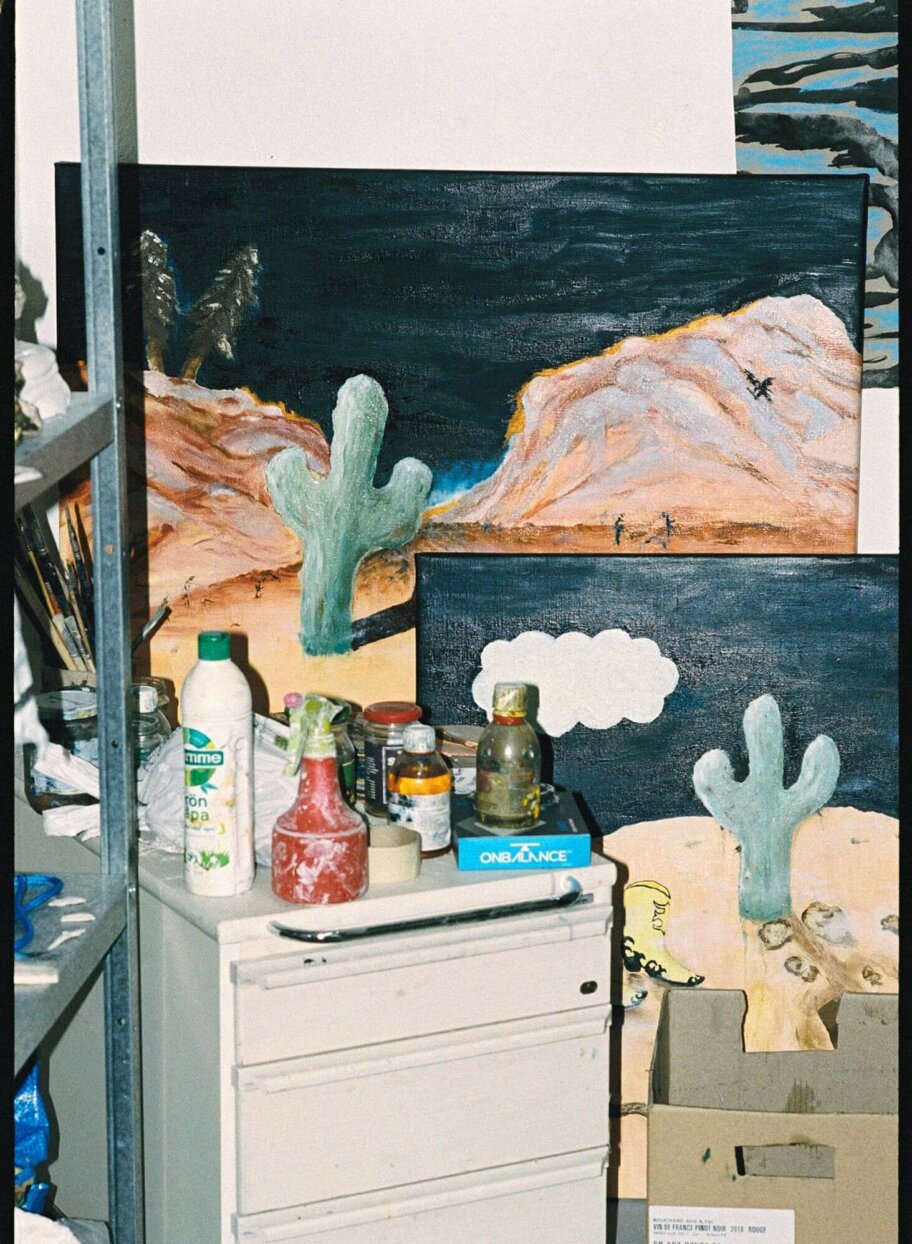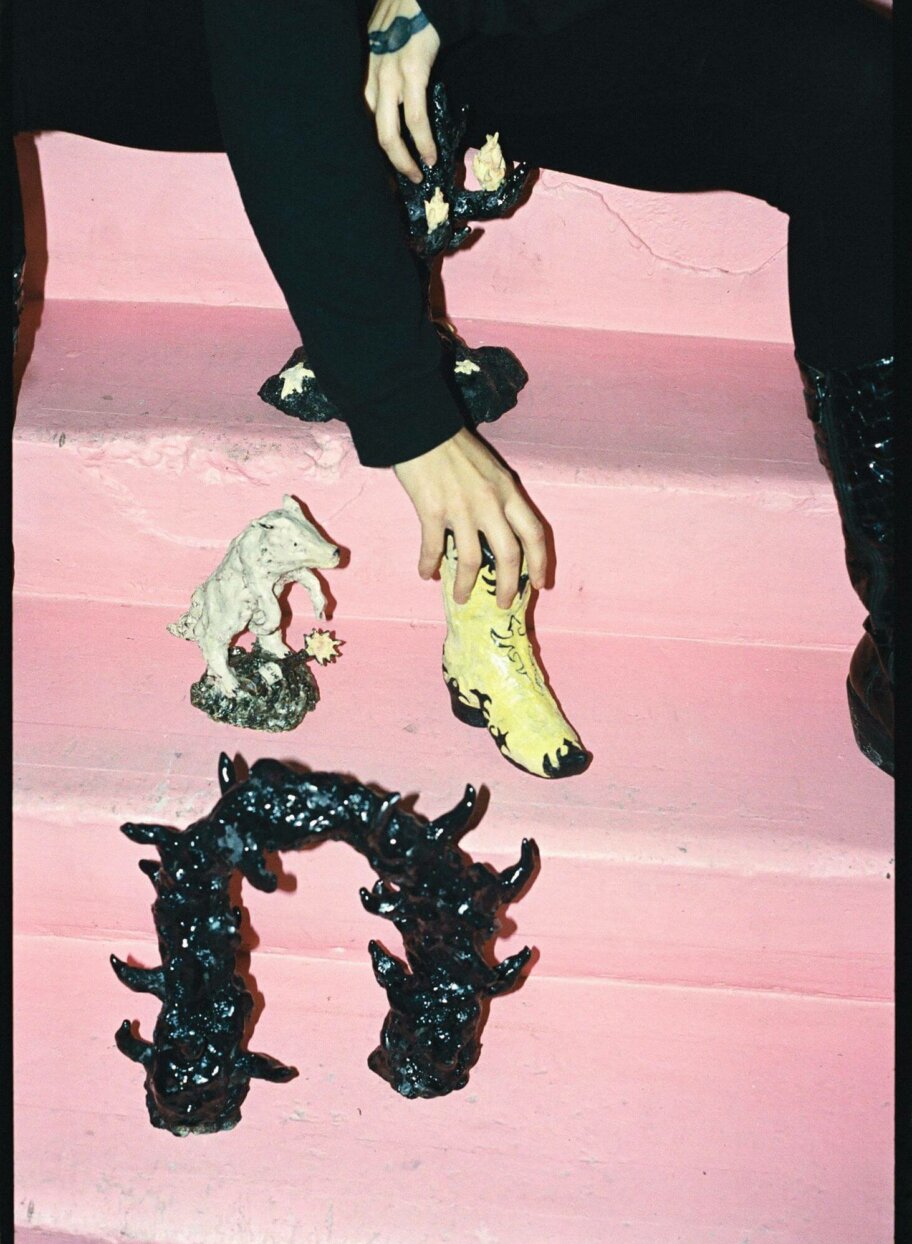
PHOTOGRAPHER KIMBERLY IHRE @kimberly_ihre
INTERVIEW JESPER GUDBERGSEN @yessirjesper
How would you describe your work to someone who has never seen it before?
Most of my sculptures are descriptive motives and characters, and most of them could be said to have a dark undertone in common. There is often a recurring theme of animal/human in both my sculptures and paintings. I enjoy creating contrasts with color, form and patterns. I sometimes work with the same motif in different ways, symbols for instance. I think the pieces in themselves could probably be experienced as raw, fast and nativistic.
Where do you get your inspiration from?
It can actually be anything that sticks with me, for one reason or another. The things that go on around me. A specific sensation on one particular day or an influential emotion that I feel the need to express. But style-wise I am also influenced by stuff like weird occult 1970s movies and – perhaps even more importantly – my lifelong closeness to subculture and the dark and raw esthetics that belong to it. Sometimes it feels like a mish mash of various things that just randomly tie together in my existence. But in general my work revolves around my own self and a portraying of the emotions therein.
Do you have a Mantra?
To just keep on going. Regardless of everything, just keep on going. Sometimes that can be the hardest thing, especially if you’re struggling creatively, which I guess most artists can relate to. But no matter what, I tend to keep wanting to explore, to see what comes out next. I shift constantly between megalomania and total self contempt. But I always try to make sure there’s some fun in it, and no matter what my mood is it’s always a liberating feeling to enter the studio. That’s my own world and only I control what’s going on.
Your sculptures emit so much emotion, what was the process behind developing your style?
Trial and error, I guess. You keep on struggling and eventually progression and style comes naturally, which is a nice feeling. For me it would be terrible to just sit and do the same thing over and over again. I am way too impatient to work like that; I have to try different materials and different approaches, otherwise I become bored. When I started out working creatively I could spend quite a long time on one piece at a time. But I realized after a while that it wasn’t an ideal method for me. It felt suffocating to work that way, like I could never reach the finish line. That gave me severe anxiety instead, it just became unbearable. So I started trying to work pretty fast and based on an acute feeling instead and that became this huge relief. I think that’s how I came to develop a more raw style which was something I had been wanting to express from the start without really knowing how to arrive there.
How do you approach starting a new piece? Is your process the same for each creation?
Many times I have this vague idea of what I want to do with my sculptures, which I allow to develop naturally during the process. But often I just get in there, being pretty hands on with the material until I realize what it is I want to say or where to bring it. Sometimes I also base the idea on an already existing piece, like a continuation on an old idea that I want to develop.

Is there another artist that you feel inspired by? Do you have a favorite piece from said artist?
Often it’s about where I am at myself in the process with my sculptures, and what I’m working on at the moment. My inspiration varies a lot based on that. Right now I feel quite inspired by Sister Gertrude Morgan and her crazy drawings and installations. There’s something hysterical about her work that becomes almost humorous. Her pieces feel raw, direct and playful but at the same time very tended to, which is a combination I appreciate a lot in art. Lately, I’ve been quite inspired in general by older afro-american folk artists like her but also Bill Taylor, Clementine Hunter, Nellie Mae Rowe to name a few. Another source of inspiration are the movies by Kenneth Anger and Alejandro Jodorowsky. There’s something very immersive in those movies that makes you forget about time and space and all other worries in life. I really enjoy that. In general I’ve always had a soft spot for people living off the grid, as well as DIY culture. Most of what’s “outside of society” so to speak, I find is inspiring both for the soul and for my work as an artist.
Tell me a little about how you became involved with clay as your primary medium for sculptures—what was it’s initial appeal? Did you make a conscious choice to work with natural materials, and if so, why?
I started becoming truly interested in clay as a medium when I was a teenager. I was drawing and painting already. But there was this feeling about working with clay that was almost religious. To shape this matter so directly with your own hands. Your thoughts and feelings could be translated simply by being in direct contact with the material without all the need for any other tools. It felt so real somehow. Since then things have just continued. I bought clay and worked at home in my apartment on the kitchen table among all the dirty dishes and I had nowhere to fire it. It became pretty messy, working in that kitchen. So I went down to the ceramic workshop which coincidentally was located on the bottom floor of the apartment building I was living, and started working from there instead. The woman who owned the place urged me to apply for art school, which I did. That’s where I got some more meat on the bones and gained the confidence to take things a bit further. After that, things escalated and I went on to another art school up North and finally got in at Konstfack a few years later.
As an artist in Stockholm, have you found a community that you identify with or are a part of?
Since my teens I have been a part of the subcultural scene in Stockholm. So I think of that world as what has identified me the most throughout the years. That was also where I began to express myself artistically by shooting photos of my friends’ bands. Around the same time I started focusing more on my own sculptures, but I still enjoy going along on tourbuses around the world, doing photography. I often feel I have one foot in the art world and one in the underground. A few years ago me and a few other female artists started a studio-collective called Ateljé Rhodos. It has been good to have this safe haven that one could turn to after finishing Konstfack, especially with people among whom I had already made a connection with, during our time at school. It has meant a lot to me to have a place to go where there are likeminded people working, and even though we all have different approaches and styles we get along really well.
There is so much unrest in the world right now, are there any changes that you’d like to see happen in the world? If so, have you portrayed them in your work?
These are very uncertain times that we live in and we’re reminded of it every day. I hope that after this pandemic we will be more aware that nothing can be taken for granted and learn to appreciate what we have. It has certainly given me a lot to think about and work on. I’m longing to travel because it makes me feel free. My last exhibition at Riche, Lilla Baren in Stockholm was based on that emotion, to be adrift in the desert in the US. But it’s unsustainable, the way we’ve traveled the last 40 years. I hope for some change in that, I believe it’s crucial for our existence.


| Cookie | Duration | Description |
|---|---|---|
| cookielawinfo-checkbox-analytics | 11 months | This cookie is set by GDPR Cookie Consent plugin. The cookie is used to store the user consent for the cookies in the category "Analytics". |
| cookielawinfo-checkbox-functional | 11 months | The cookie is set by GDPR cookie consent to record the user consent for the cookies in the category "Functional". |
| cookielawinfo-checkbox-necessary | 11 months | This cookie is set by GDPR Cookie Consent plugin. The cookies is used to store the user consent for the cookies in the category "Necessary". |
| cookielawinfo-checkbox-others | 11 months | This cookie is set by GDPR Cookie Consent plugin. The cookie is used to store the user consent for the cookies in the category "Other. |
| cookielawinfo-checkbox-performance | 11 months | This cookie is set by GDPR Cookie Consent plugin. The cookie is used to store the user consent for the cookies in the category "Performance". |
| viewed_cookie_policy | 11 months | The cookie is set by the GDPR Cookie Consent plugin and is used to store whether or not user has consented to the use of cookies. It does not store any personal data. |